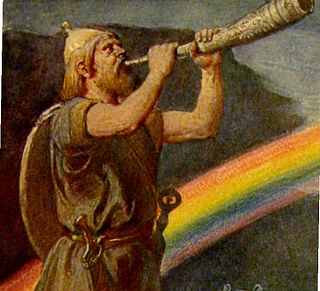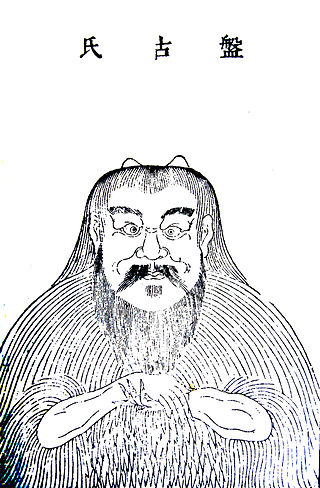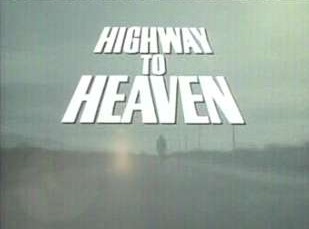
In Norse mythology, Bifröst, also called Bilröst, is a burning rainbow bridge that reaches between Midgard (Earth) and Asgard, the realm of the gods. The bridge is attested as Bilröst in the Poetic Edda, compiled in the 13th century from earlier traditional sources; as Bifröst in the Prose Edda, written in the 13th century by Snorri Sturluson; and in the poetry of skalds. Both the Poetic Edda and the Prose Edda alternately refer to the bridge as Ásbrú.

Flat Earth is an archaic and scientifically disproven conception of the Earth's shape as a plane or disk. Many ancient cultures subscribed to a flat-Earth cosmography, notably including ancient near eastern cosmology. The model has undergone a recent resurgence as a conspiracy theory.

Heaven, or the heavens, is a common religious cosmological or transcendent supernatural place where beings such as deities, angels, souls, saints, or venerated ancestors are said to originate, be enthroned, or reside. According to the beliefs of some religions, heavenly beings can descend to Earth or incarnate and earthly beings can ascend to Heaven in the afterlife or, in exceptional cases, enter Heaven without dying.
In Germanic cosmology, Midgard is the name for Earth inhabited by and known to humans in early Germanic cosmology. The Old Norse form plays a notable role in Norse cosmology.

"The Last Flight" is the eighteenth episode of the American television anthology series The Twilight Zone. Part of the production was filmed on location at Norton Air Force Base in San Bernardino, California. The vintage 1918 Nieuport 28 biplane was both owned and flown by Frank Gifford Tallman, and had previously appeared in many World War I motion pictures.

Pangu is a primordial being and creation figure in Chinese mythology and Taoism. According to the legend, Pangu separated heaven and earth, and his body later became geographic features such as mountains and roaring water.
The concept of the kingship of God appears in all Abrahamic religions, where in some cases the terms kingdom of God and kingdom of Heaven are also used. The notion of God's kingship goes back to the Hebrew Bible, which refers to "his kingdom" but does not include the term "Kingdom of God".

Máni is the Moon personified in Germanic mythology. Máni, personified, is attested in the Poetic Edda, compiled in the 13th century from earlier traditional sources, and the Prose Edda, written in the 13th century by Snorri Sturluson. Both sources state that he is the brother of the personified sun, Sól, and the son of Mundilfari, while the Prose Edda adds that he is followed by the children Hjúki and Bil through the heavens. As a proper noun, Máni appears throughout Old Norse literature. Scholars have proposed theories about Máni's potential connection to the Northern European notion of the Man in the Moon, and a potentially otherwise unattested story regarding Máni through skaldic kennings.

Jacob's Ladder is a ladder leading to heaven that was featured in a dream the biblical Patriarch Jacob had during his flight from his brother Esau in the Book of Genesis.

In ancient near eastern cosmology, the firmament means a celestial barrier that separated the heavenly waters above from the Earth below. In biblical cosmology, the firmament is the vast solid dome created by God during the Genesis creation narrative to separate the primal sea into upper and lower portions so that the dry land could appear.

In mythological or religious cosmology, the seven heavens refer to seven levels or divisions of the Heavens. The concept, also found in the ancient Mesopotamian religions, can be found in Judaism and Islam; the Christian Bible does not mention seven levels of heaven. Some of these traditions, including Jainism, also have a concept of seven earths or seven underworlds both with the metaphysical realms of deities and with observed celestial bodies such as the classical planets and fixed stars.

"Heaven Is a Place on Earth" is a single by American singer Belinda Carlisle from her second studio album, Heaven on Earth (1987). Written by Rick Nowels and Ellen Shipley, the song was released as the lead single from the album on September 14, 1987, and it reached number one on the US Billboard Hot 100 on December 5, 1987, becoming Carlisle's only US chart-topper to date. A month later it peaked at number one in the United Kingdom, where it held the top spot of the UK Singles Chart for two weeks. In Australia it peaked at number 2. It is considered to be Carlisle's signature song.
Earth and Heaven were worshiped by various Hurrian communities in the Ancient Near East. While considered to be a part of the Hurrian pantheon, they were not envisioned as personified deities. They were also incorporated into the Mesopotamian pantheon, possibly during the period of Mitanni influence over part of Mesopotamia, and under the names Hahharnum and Hayyashum appear in a variety of texts, including the myth Theogony of Dunnu.

The War in Heaven is a mythical conflict between supernatural forces in traditional Christian cosmology, attested in the Book of Revelation alongside proposed parallels in the Hebrew Bible and the Dead Sea Scrolls. It is described as the result of the Archangel Satan rebelling against God and leading to a war between his followers and those still loyal to God, led by the Archangel Michael. Within the New Testament, the War in Heaven provides basis for the concept of the fallen angels and for Satan's banishment to Christian Hell. The War is frequently featured in works of Christian art, such as John Milton's epic poem Paradise Lost, which describes it as occurring over the course of three days as a result of God the Father announcing Jesus Christ as His Son.
Heaven on Earth is an ancient and active tenet for a possible world to come. The phrase may also refer to:

Himmel und Erde is a traditional German dish of mashed potato with stewed apples. It is frequently served with sliced blood sausage.

The New Earth is an expression used in the Book of Isaiah, 2 Peter, and the Book of Revelation (21:1) in the Bible to describe the final state of redeemed humanity. It is one of the central doctrines of Christian eschatology and is referred to in the Nicene Creed as the world to come.

Highway to Heaven is an American fantasy drama television series that ran on NBC from September 19, 1984, to August 4, 1989. The series starred its creator and co-director Michael Landon as Jonathan Smith, an angel sent to Earth in order to help people in need. Victor French, Landon's co-star from his previous television series, Little House on the Prairie, co-starred as Mark Gordon, a retired policeman who travels with and helps Smith with the tasks or "assignments" to which he is referred. The series was created by Landon, who was the executive producer and also directed most of the show's episodes. French directed many of the remaining episodes. It was Landon's third and final TV series and his only one set in the present day, unlike Little House on the Prairie, and Landon's first TV series, Bonanza, both of which were Westerns. It was the final screen appearance for French, who died two months before the final episode aired, aged 54 years old; Landon went on to appear in two films, one of which was a pilot for a new series, prior to his own death at 54 in 1991.

Heaven & Earth is the twenty-first studio album by the English progressive rock band Yes. It was released on 16 July 2014 on Frontiers Records and is the first album with lead vocalist Jon Davison and the final album to feature founding bassist Chris Squire before his death in 2015. The group started preparing new material for an album during the 2013 leg of their Album Series Tour. Davison took an active approach with the songwriting, travelling to the homes of the other band members to collaborate on songs. Yes enlisted producer Roy Thomas Baker and future Yes bassist Billy Sherwood to complete the mixing.
Between Heaven and Earth may refer to:














